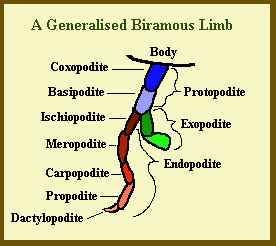On the diagram showing the spider family tree, what's supposed to be off the left side of the page and what sits at the first two branches? Where's the creature that's sort of a horse shoe crap and sort of a sea spider but not really either one? Was there ever a creature that didn't have eight legs and slowly but surely turned into a creature that does have eight legs?
There's a lot of fossils not shown here. I'll see what I can find. The important thing is that morphology is not always a good guide to descent. King crabs, for example, are genetically closer relatives to hermit crabs than to other "crab-looking crabs."
And because tagmosis is the way that arthropod body plans change, loss of legs is relatively simple, with changes in homeotic genes governing development. The ur-arthropod would have been something like a centipede, with little difference in each biramous segment.
By "biramous" I mean that each segment would have a pair of gills and a pair of legs. The evidence shows that gills were largely lost in terrestrial arthropods, but one or two pair became wings. And yes, there are transitional forms like stoneflies.
Tagmosis reduces the number of segments, and alters the development of appendages. In spiders, the cephalothorax is comprised of a number of body segments, greatly altered. The chelae and pedipalps are modified legs, each with their own (no longer distiguishable) body segment.
Again, I really am not trying to focus on spiders here. It's just turned into a convenient avenue to go down toward the final destination.
Like chordates, they are bilaterans, and the Hox genes are related in many ways to those of chordates.
Also, notice that there is DNA for legs or there isn't, right?
Yes. But those genes are modified by developmental genes for each segment. So the appendages might be legs in one segment and chelae in others, and not developed at all in others. It's kinda like phalanges in vertebrates. There's no code directly specifying how many digits a vertebrate has. The limb bud, in development, has a bit of tissue that grows and hooks across the front of the bud. As it goes across, it pops out digits. The length of time it takes to do that determines how many, and that is determined by other genes that mediate development. This is why large dogs often have a sixth digit; they take longer in development and thereby get an extra one.
I mean, where did the DNA code for legs come from? How long is the DNA code for legs, hundred of base pairs, thousands? Is it longer or shorter than the DNA code for fins, or is it just different (i.e. not longer or shorter just different)?
It's different for arthropods and vertebrates. But the earliest organisms with "legs" in the line that leads to arthropods were onychophorans:
How much different is it? Is it a lot different or just a little incy-wincy bit different.
It's not a simple set of instructions. There's a basic plan, common to all of these organisms, and then a developmental plan that modifies the basic plan. And I'm greatly oversimplifying here.
(See what I did there! "incy-wincy spider" - get it?

)
Yep. :chuckle: Depending on what the gene is, a small change can have very great effects.
Great questions; this is a very productive thread.

